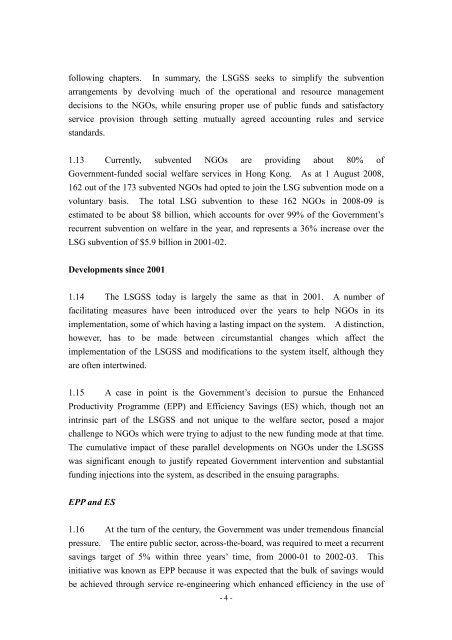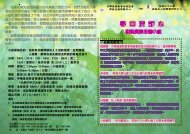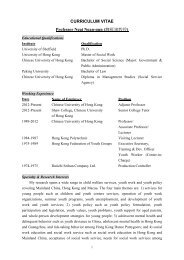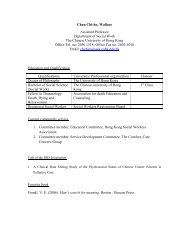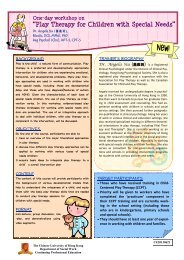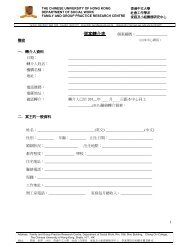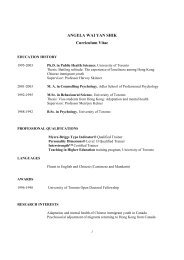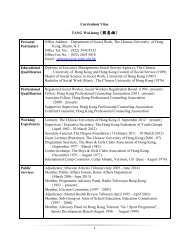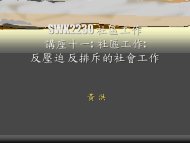Review Report on the Lump Sum Grant Subvention ... - lwb.gov.hk
Review Report on the Lump Sum Grant Subvention ... - lwb.gov.hk
Review Report on the Lump Sum Grant Subvention ... - lwb.gov.hk
You also want an ePaper? Increase the reach of your titles
YUMPU automatically turns print PDFs into web optimized ePapers that Google loves.
following chapters. In summary, <strong>the</strong> LSGSS seeks to simplify <strong>the</strong> subventi<strong>on</strong>arrangements by devolving much of <strong>the</strong> operati<strong>on</strong>al and resource managementdecisi<strong>on</strong>s to <strong>the</strong> NGOs, while ensuring proper use of public funds and satisfactoryservice provisi<strong>on</strong> through setting mutually agreed accounting rules and servicestandards.1.13 Currently, subvented NGOs are providing about 80% ofGovernment-funded social welfare services in H<strong>on</strong>g K<strong>on</strong>g. As at 1 August 2008,162 out of <strong>the</strong> 173 subvented NGOs had opted to join <strong>the</strong> LSG subventi<strong>on</strong> mode <strong>on</strong> avoluntary basis. The total LSG subventi<strong>on</strong> to <strong>the</strong>se 162 NGOs in 2008-09 isestimated to be about $8 billi<strong>on</strong>, which accounts for over 99% of <strong>the</strong> Government’srecurrent subventi<strong>on</strong> <strong>on</strong> welfare in <strong>the</strong> year, and represents a 36% increase over <strong>the</strong>LSG subventi<strong>on</strong> of $5.9 billi<strong>on</strong> in 2001-02.Developments since 20011.14 The LSGSS today is largely <strong>the</strong> same as that in 2001. A number offacilitating measures have been introduced over <strong>the</strong> years to help NGOs in itsimplementati<strong>on</strong>, some of which having a lasting impact <strong>on</strong> <strong>the</strong> system. A distincti<strong>on</strong>,however, has to be made between circumstantial changes which affect <strong>the</strong>implementati<strong>on</strong> of <strong>the</strong> LSGSS and modificati<strong>on</strong>s to <strong>the</strong> system itself, although <strong>the</strong>yare often intertwined.1.15 A case in point is <strong>the</strong> Government’s decisi<strong>on</strong> to pursue <strong>the</strong> EnhancedProductivity Programme (EPP) and Efficiency Savings (ES) which, though not anintrinsic part of <strong>the</strong> LSGSS and not unique to <strong>the</strong> welfare sector, posed a majorchallenge to NGOs which were trying to adjust to <strong>the</strong> new funding mode at that time.The cumulative impact of <strong>the</strong>se parallel developments <strong>on</strong> NGOs under <strong>the</strong> LSGSSwas significant enough to justify repeated Government interventi<strong>on</strong> and substantialfunding injecti<strong>on</strong>s into <strong>the</strong> system, as described in <strong>the</strong> ensuing paragraphs.EPP and ES1.16 At <strong>the</strong> turn of <strong>the</strong> century, <strong>the</strong> Government was under tremendous financialpressure. The entire public sector, across-<strong>the</strong>-board, was required to meet a recurrentsavings target of 5% within three years’ time, from 2000-01 to 2002-03. Thisinitiative was known as EPP because it was expected that <strong>the</strong> bulk of savings wouldbe achieved through service re-engineering which enhanced efficiency in <strong>the</strong> use of- 4 -


